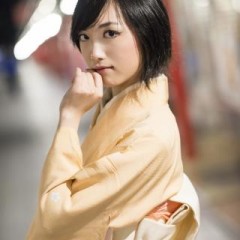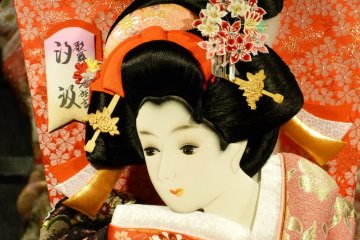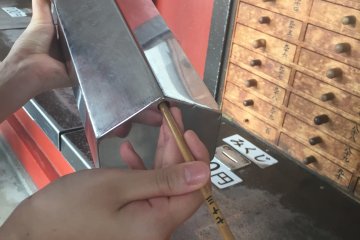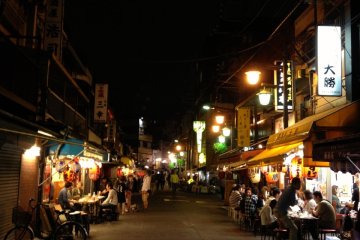Senso-ji, or the Asakusa Temple as it is informally called, is one of the most visited tourist spots in Tokyo. Built in 645AD to honor the goddess (or maybe god, depending on your take on it) of mercy, Kannon, a statue of which was fished out in the Sumida River. As the oldest temple in Tokyo, Senso-ji was a famous place of pilgrimage, and the "Nakamise" streets around it grew to become busy with merchants. The Asakusa Shrine was built in 1649 and sits to the right of the main temple building.
The inevitable reality of tourism means that the best sights are always crowded, and Senso-ji is no exception. During the day it is bustling with activities. Tourists with cameras around their necks mingle with Japanese students on school trips. Huge rivers of people flow past shores lined by shops displaying a dazzling array of goods. This is the daytime Sensoji.

Come nightfall, Senso-ji is transformed into a different world. Night closes in and the shops pack up and lower their shutters. Crowds gradually trickle away, leaving empty streets. Then the illuminations come on and bathe the temple in golden light, making the reds and the yellows stand out in saturated details against the night sky. Along the main shopping street, racks of goods are replaced by shutters painted with traditional Japanese motifs and designs, an open-air art display you can view as you stroll along. And the best part of the night is its silence, which amplifies the temple and its surrounding streets all in a breathtaking display.
The lights in Senso-ji were installed and started operating from October 1st in 2003, designed by Motoko Ishii, whose works also include illuminations for Tokyo Tower and Rainbow Bridge. Even though they were designed with energy-saving in mind, the lights in Senso-ji do a terrific job highlighting the vivid reds of the temple. Even better, the lights were so positioned that they are completely unobtrusive to the point that they slip from your notice unless you make the point of looking for them.
The best time to go is on a weekday evening (except Fridays), and between sundown and 11pm. Given Japan's latitude, this means going after 9pm in the middle of summer. If you go too early right after the shops close, a few lost tourists will have yet to drift away. On the other hand, going too late raises your risk of running into drunk Japanese salary-men (though perhaps you would like to observe this slice of real Tokyo life).
There are quite a number of eateries of various price ranges in the roofed shopping streets around the temple, where you can grab dinner before heading out into the night. Walk further in the direction of the temple and you can find, on streets running parallel to the main avenue, rows of very authentically local-looking establishments with tables spilling out onto the pavement, and handwritten menus trumpeting the day's specials.
Wandering along in night-time Senso-ji without its daytime crowd can feel like you're stepping into the secretive, private life of old Tokyo. As you walk down the quiet pavement, sometimes, in one rare moment, you may feel finally permitted to shed that shell which marks you out as a tourist, to soak up the air rich with the scent of Tokyo, old, new, and all rolled into one.











